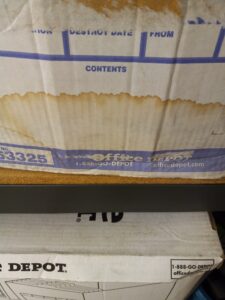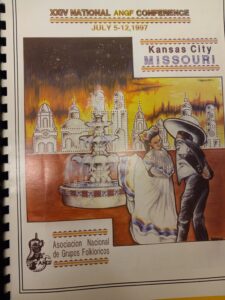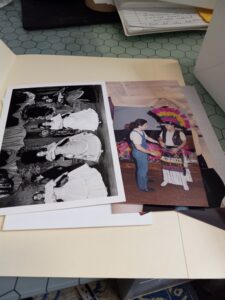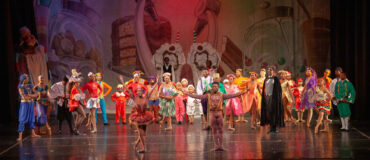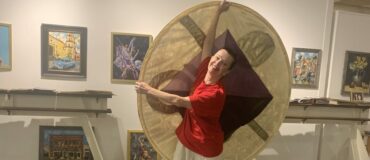By Tere Elizalde
Tere Elizalde is a 2022 Archiving and Preservation Fellow with Guadalupe Cultural Arts Center/Guadalupe Dance Company. Read more about the Fellowships here. This is the second part of Tere’s blog. Read the first part here.
September 15, 2022: Materials Tell the Story
Since completing my initial archive assessment, I’ve been doing a lot of inventory work at GCAC (Guadalupe Cultural Arts Center), developing policies and procedures for staff to follow for the archive, and educating staff about how to continue the inventory. During this time, I learned more about the history and activities of the Dance Company and Academy and how preservation is inherent in every part of archiving.
Early on, Belinda Menchaca invited me to a dinner with her, Jeannette Chavez, and several of the Dance Company members. From them, I got to hear a bit about their experiences over the years, including some of their major activities as a company member but also other expectations for company members. For instance, not only are they performers in a professional dance company, but they also will put in time as instructors to students in the Dance Academy. Several members started off as academy students before becoming a part of the company as well. As a result, company members help actualize the center’s mission and vision in different roles throughout their career.
In addition, a recurring word during our dinner together was “ANGF,” or la Asociación Nacional de Grupos Folklóricos, which the company participates in regularly, including this summer. Groups perform, showcase their work, and learn from each other in various practices, lectures, and workshops during the conference, focusing on various styles of Mexican folkloric dance. Activities such as this also help the Dance Company learn new forms of dance to incorporate in their routines, such as stilts, and keep the knowledge of these dance forms alive.
I was also able to view the recital “Fiesta de Verano” to get my first in-person experience of dances studied at the Dance Academy. Students of all ages learn at the Dance Academy and get a chance to perform what they practiced over several months. By attending the recital, not only did I get a program of the sequence of performances, I saw and heard the different types of dances, each with their own unique music and costume associated with them. This type of content allowed me to cross-reference other materials and provide richer content in my inventory, as these styles and the music associated with them would appear again and again.
Although adding more information to an inventory takes more time, I was able to get more contextual information for the inventory and distinguish between different parts of the descriptive metadata. Just these two experiences were beneficial in identifying more of the content which helps to identify what content staff may want to prioritize in future phases of the project, including digitization.
It also helped to identify content that would be unique to their dance archive. For example, baile folklorico is not just one style of dance but has numerous regional variations such as Jalisco, Veracruz, Baja California, and more. As part of their educational mission, instructors teach different regional styles, so adding the region when possible would show what archival materials would be beneficial for educational use.

Several AV materials found in the dance archive about Rio Bravo along with other recorded content including De Jarocha a Pocha and educational outreach with “Fiesta Folklorica.”
During this time, I began my inventory with AV materials because I could record each item as its own distinct unit. This approach was straightforward and would be quickest for staff to continue my work. Although I could not view the material due to the lack of playback equipment, I could use the contextual information I began learning about to add the descriptive metadata, add onto it by cross-referencing other materials, and have staff provide their knowledge too. Since both the main organization and the Dance Department have a thirty-plus year history, staff used many different AV formats to record their activities. For instance, while doing AV inventory, I regularly saw different formats over the years pertaining to ANGF with different types of content including rehearsals on VHS or cassettes with the track list of the songs used in their demonstration.
I also saw and heard about recurring mentions of other significant activities over their history. For example, the ballet Rio Bravo was a landmark in the Dance Company’s history. Rio Bravo depicts the history of what is often referred to as Rio Grande, and features the dances and music of the people and cultures of that region through several movements. Its importance was evident as I worked on the inventory. While video tapes were frequent, the range of AV formats and content with material on Rio Bravo included cassettes with music, different angles and languages of performance footage on VHS and Betacam, and more.
After working on the onsite AV materials, I began inventorying other types of materials including paper-based and different formats of photographs. Unlike the AV inventory, these were often put haphazardly into boxes and mixed together. As a result, preservation continued to be important throughout the inventory process. While I previously did an overview in my initial preservation assessment, this time I could handle materials on a smaller scale, going through the boxes and folders to see if there were more pressing issues to address. Fortunately, there were few paper or photograph-based items that were in dire condition. Instead, the more pressing issues were to rehouse items that had water damage into suitable boxes and folders, to separate photographs and newspapers from other formats, and to remove non-archival items. It was a contrast to the process for AV materials, where I noted any condition concerns regarding these materials such as labeling, missing or broken cases, scratches, or evidence of mold and odor that would need to be addressed with preservation measures.
- Boxes with signs of water damage and warping.
- An AV item quarantined and separated due to preservation concerns.
For me personally, going through the paper-based and photograph materials was exciting. Flipping through different materials even briefly, I found additional records that helped provide contextual information for the AV inventory including information on ANGF in various booklets including the programming, research for Rio Bravo, and various records related to educational outreach, classes, and members of the Dance Company when young. More importantly, these materials help to better understand the story of the activities, the dances, and the dancers themselves.
- An ANGF booklet from 1997.
- Promotional material for the Rio Bravo Ballet
- Photographs being rehoused into folders.
Working on the inventory and continuing my preservation assessment also provided a better understanding of how to approach the other significant portion of my project, the policies and procedures guide for staff to utilize for the archive.
Recording the process, my observations, and discussions with staff on their collection, I began drafting portions of the guide for inventory, use, and preservation, and taking the time to implement measures bit by bit. While it is still a work in progress, this draft also played a role in demonstrating the work I have been doing with staff. Since I am a thought partner in the project, it is important to continue to get their feedback and insight on the work I am doing. Using the draft as a guide, I had several opportunities to demonstrate different parts of archiving including handling and inventory. One of the staff members, Connie Espinoza, will be taking the lead after the summer. We put aside some time to run through the process, practice, and ask questions. Although seemingly straightforward, we both had questions on very similar metadata such as titles and dates for AV. While it seems simple to transcribe the title on a media, sometimes AV will have multiple titles that might contradict each other or dates may be for the item creation rather than the date of the activity documented. In addition, her knowledge about the activities of the Dance Company and Dance Academy and forms of dance provided rich metadata for inventorying photographic materials, improving my initial inventory work. Through our work together, we’ll be creating a much more detailed and useful resource for the dance archive.

A snapshot from the AV inventory demonstration filled out by Connie Espinoza.
All photos courtesy of the author.
 Tere Elizalde is pursuing a master’s degree in information science at the University of Michigan’s School of Information, focusing on Digital Archives, Library Science, and Preservation. Prior to studying archives, she obtained her MA in International and Regional Studies from the University of Michigan in 2021.
Tere Elizalde is pursuing a master’s degree in information science at the University of Michigan’s School of Information, focusing on Digital Archives, Library Science, and Preservation. Prior to studying archives, she obtained her MA in International and Regional Studies from the University of Michigan in 2021.
Drawn to how history impacts people’s way of interacting and understanding information, she sought out archives as a way to engage with underrepresented communities and increase their visibility and stories in collections to reshape societal narratives about history.
Currently working at the Bentley Historical Library as a Reference Assistant, she gets to experience and understand how various audiences interact with archives, and uses it to inform her archival practice.
Tere is looking forward to bringing her past and current experiences in research, reference, preservation, and community engagement to work alongside the Guadalupe Cultural Arts Center this summer to begin the process of creating a sustainable and community-accessible archive that features the center’s rich and cultural engagement with dance.
____
We accept submissions on topics relevant to the field: advocacy, artistic issues, arts policy, community building, development, employment, engagement, touring, and other topics that deal with the business of dance. We cannot publish criticism, single-company season announcements, and single-company or single artist profiles. Additionally, we welcome feedback on articles. If you have a topic that you would like to see addressed or feedback, please contact communications@danceusa.org.
Disclaimer: Opinions expressed in guest posts do not necessarily represent the viewpoints of Dance/USA.


